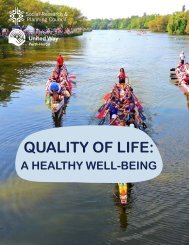2023-12-05 A Clean Environment
Create successful ePaper yourself
Turn your PDF publications into a flip-book with our unique Google optimized e-Paper software.
These three conservation authorities release watershed report cards<br />
measuring groundwater quality, surface water quality, forest conditions<br />
and wetland conditions. The report cards allow authorities to benchmark<br />
conditions, measure change, identify issues and track progress for actions.<br />
The following grading system is used to evaluate the condition of these<br />
areas:<br />
Grades<br />
A: Excellent – Very healthy watershed conditions<br />
B: Good – Healthy watershed conditions<br />
C: Fair – Watershed conditions require improvement<br />
D: Poor – Poor watershed conditions, require improvement<br />
F: Very Poor – Watershed significantly degrading, require much<br />
improvement<br />
Insufficient Data<br />
Surface Water Scores Are Consistent With Provincial<br />
Average<br />
Surface water makes up rivers, lakes and streams. Surface water quality<br />
is assessed by measuring several indicators F for water chemistry and the<br />
health of small organisms living in streams and on riverbeds. Findings from<br />
Ontario indicate surface water quality decreases the closer the source of<br />
water is to an urban area. There can be multiple sources of discharge in<br />
highly populated areas, including winter salt application or stormwater<br />
runoff. The average score for surface water in Ontario is C, indicating<br />
“fair” surface water quality. 17 Both Maitland Valley and Ausable Bayfield<br />
Conservation Authorities matched the provincial average with C scores. 18,19<br />
Upper Thames Conservation Authority also averaged a C score but<br />
received slightly more D scores in some areas. 20<br />
F<br />
The quality indicators are as follows: total phosphorus concentrations,<br />
benthic macroinvertebrates (small organisms whose numbers indicate the<br />
level of pollution in water), E. coli levels and salts (e.g., road salt and de-icers).<br />
RECOMMENDATIONS<br />
Individuals can improve surface water quality by<br />
reducing or eliminating the use of chemicals such as<br />
backyard pesticides.<br />
Individuals and businesses limit the use of<br />
chemicals, including fertilizers and winter salt, and<br />
always use and store these chemicals correctly to<br />
help protect groundwater.<br />
Page 13 A <strong>Clean</strong> <strong>Environment</strong>
















